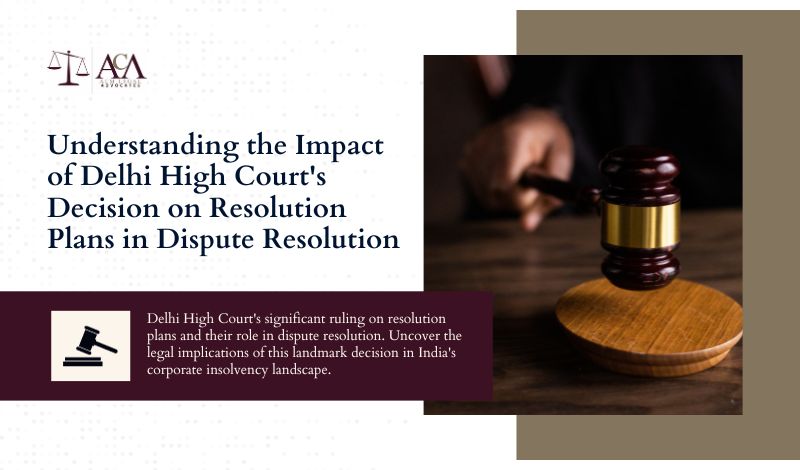A recent and significant legal decision by the Delhi High Court addressed a complex matter involving Indian Oil Corporation Ltd (IOCL) and Arcelor Mittal Nippon Steel India Ltd. By way of two Assignment Agreements between IOCL, ESIL and EOL, together valid up to September 30, 2015, ESIL had assigned all its rights and obligations as flowing from the GSA to EOL. Then, on May 4, 2016, IOCL sent ESIL a notice about its non-compliance with the 2015 contract year’s Adjusted Annual Contract Quantity (“AACQ”) and also used Article 14.1 of the gas supply agreement to demand payment. This judgement adds another layer to the evolving landscape of India’s corporate insolvency resolution process, following in the footsteps of the famous Essar Steel India Ltd (ESIL) case. The Essar Case is important because it established the principle that once a Resolution Plan is approved by the COC and the relevant authorities, it leads to the final settlement of all claims against the distressed company, except for those specifically included in the plan.
This principle is cited by the Delhi High Court in the IOCL vs. Arcelor Mittal Nippon Steel India Ltd. case to support its decision that disputes covered by an approved Resolution Plan cannot be reintroduced for arbitration. This case has become another integral part of the evolving landscape of the Corporate Insolvency Resolution Process (CIRP) in India.
Table of Contents
ToggleDispute
The main dispute was for a gas supply agreement between Indian Oil Corporation Ltd (IOCL) and Essar Steel India Ltd (ESIL). This agreement contained a clause stating that if ESIL didn’t purchase the agreed amount of gas, they would owe IOCL money. ESIL had assigned its rights and obligations under the contract to Essar Oil Ltd (EOL) in 2015. However, IOCL claimed that ESIL had not met certain contract terms and demanded payment in 2016. ESIL terminated the contract in 2017, but IOCL disputed the termination, saying it hadn’t violated the contract. This led to legal proceedings and arbitration. While these disputes were ongoing, ESIL faced financial trouble and banks filed for insolvency against ESIL in 2017. A Resolution Professional (RP) was appointed and IOCL’s claim for payment was reduced to just ₹1. Later, in 2018, the Committee of Creditors accepted a Resolution Plan from Arcelor Mittal to acquire ESIL. The plan was approved by the court. However, there was a disagreement over the amount of money IOCL should receive. The Supreme Court eventually ruled in favour of the Resolution Professional’s decision to admit IOCL’s claim at ₹1 and approved Arcelor Mittal’s acquisition of ESIL. After the acquisition, IOCL requested payment according to the original contract, but Arcelor Mittal refused. IOCL then tried to initiate arbitration to resolve the payment dispute, but Arcelor Mittal didn’t respond. So, IOCL filed a lawsuit in the Delhi High Court.
The Delhi High Court's Key Ruling
The Delhi High Court made a crucial decision. They observed that when a resolution plan is approved under the Insolvency and Bankruptcy Code (IBC), it wipes out most of the debts a struggling company owes, except for those specifically mentioned in the plan. In simple terms, it gives the company a fresh start. In this case, IOCL’s claim was not among the exceptions listed in the approved resolution plan. So, the Delhi High Court said that the dispute couldn’t be brought to the Arbitral Tribunal. Doing so would be like reopening the resolution plan, which is not allowed.
Two critical cases influenced the outcome of Delhi High Court’s legal decision in the present case.
- Essar Steel (India) Ltd. Committee of Creditors of v. Satish Kumar Gupta (Essar Case): This landmark case cemented the principle that an approved resolution plan acts as a financial eraser, wiping out most of a company’s historical debts. It is this precedent that forms the bedrock of the Delhi High Court’s decision.
- Ghanashyam Mishra and Sons Pvt. Ltd. v. Edelweiss Asset Reconstruction Company Ltd (Ghanashyam’s Case): This case shed light on the intricacies of claim admission during insolvency proceedings. It demonstrated that disputes regarding the admission of claims can undergo legal inspection.
The Delhi High Court’s judgement in the IOCL vs. Arcelor Mittal Nippon Steel India Ltd. case adds more clarity to the world of corporate insolvency resolution process. It emphasises the importance of approved resolution plans and their impact on disputes, providing a fair and structured way to resolve financial difficulties while protecting the rights of all parties involved.
Key Takeaways
- Once a plan is approved to save a struggling company, it clears most of the company’s old debts.
- Disputes that were part of the insolvency process should be resolved according to the plan.
- This decision helps maintain the fairness and integrity of the insolvency and arbitration processes.
- The court has the power to stop disputes from going to arbitration if they are not supposed to be resolved that way, even if there’s an arbitration agreement.
Conclusion
The Delhi High Court’s landmark decision in the IOCL vs. Arcelor Mittal Nippon Steel India Ltd. case has added another layer of clarity to the complex landscape of India’s corporate insolvency resolution process (CIRP). This judgement reaffirms the principle established in the famous Essar Steel India Ltd. (ESIL) case, emphasising that once an approved resolution plan is in place, it acts as a financial eraser, wiping out most of the historical debts of a struggling company.
In essence, this decision helps maintain the fairness and integrity of both the insolvency and arbitration processes. It provides clarity for resolving financial difficulties while safeguarding the rights of all parties involved. The Delhi High Court’s ruling in this case contributes significantly to the evolving landscape of corporate insolvency resolution in India, setting important precedents for future cases and ensuring a more predictable and structured approach to resolving financial distress.






